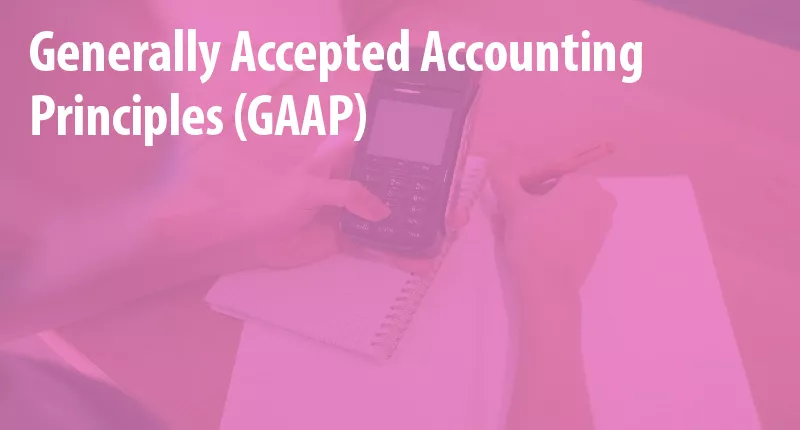
TABLE OF CONTENTS
If you’re looking to get your business’s financial health on track, you may come across the Generally Accepted Accounting Principles. The Generally Accepted Accounting Principles (GAAP) are more than just a set of processes and procedures that businesses must follow. GAAP helps protect consumers, investors, and business owners from fraud. It also creates a consistent measure of accounting reports for all businesses. Although publicly traded companies must follow GAAP rules, the majority of small businesses will follow them as well. Let’s explore these accounting principles and how they relate to your business.
The Generally Accepted Accounting Principles (GAAP)
The reason the generally accepted accounting principles exist is to keep a standard for publicly traded companies. Regulated by the U.S. Securities and Exchange Commission, GAAP sets a standard for the terminology and practices for business accounting. Having these accounting principles in place allows for transparency and a balance across industries.
There are nine GAAP accounting principles to take note of. Each one relates to a different aspect of accounting and helps businesses balance their books. While GAAP is standard for publicly traded organizations, small businesses can also glean some knowledge from these principles. As always, refer to your CPA in the event any of these accounting principles seem foreign or confusing.
Economic entity assumption
The economic entity assumption is the principle that keeps the sole proprietor’s business transactions separate from the owner’s personal transactions. This is the case regardless of whether the sole proprietorship is legally separate from the owner or not.
Monetary unit assumption
This assumption states that businesses must use the same currency to record all business activity. Businesses that deal with foreign transactions have additional work to do to ensure that their bookkeeping is accurate.
Additionally, under this assumption is also the idea that purchasing power of currency is static over time. That means inflation is not considered when creating the financial reports of a business, regardless of how long that business has been operating.
Specific time period assumption
When using GAAP, dates are extremely important. For example, a balance sheet will report on information as of a specified state. Income statements will have a date range. Any financial statement a business creates must indicate the time period of the activity they are reporting. The specific time period assumption states that in order for financial documents to be meaningful, they must clearly indicate a date range or time period.
Full disclosure principle
Falling to abide by the full disclosure principle is often a reason that a business makes the news. This principle says that a business must disclose all information that is related to the function of its financial statements in notes that accompany the statements. The idea behind this principle is to help ensure that businesses don’t mislead stockholders and investors by any part of their financial reports.
Going concern principle
The going concern principle assumes that a business will function and exist indefinitely. This assumption allows a business to defer recognizing expenses for a later accounting period. It also gives stockholders and investors assurance in the organization’s longevity.

Matching principle
Most small businesses report revenue when they receive cash and expenses when they spend it. For tax purposes, they use this cash basis. However, there are certain businesses that must report all their financial information on an accrual basis. This is primarily due to the matching principle.
Under the matching principle, a business must use the same accounting period for sales and expenses that they do to produce those sales. Wages, sale commissions, etc. are examples of these expenses. Small businesses that use a cash basis for their tax return will still typically have their accountant prepare financial reports on an accrual basis.
Revenue recognition principle
Just like the matching principle, the revenue recognition principle is an accrual basis accounting principle. Under this principle, businesses report revenue when they earn it. This is without regard for when the customer pays for the product or receives the service. For example, if a customer buys a product from you, you would record the revenue, even if the payment has not yet been collected.
Materiality principle
The materiality principle allows accountants to use their best judgment when recording a transaction or to address an error. It is common to see this principle in action when an accountant is completing a tax return or reconciling the books. If there is a discrepancy that changes the account by a relatively small amount, your CPA may deem it immaterial.
Conservation principle
The conservation principle is the second GAAP principle that allows accountants to use their best judgment in a situation. This principle guides the accountant to choose the option that yields the most conservative results for the business when there’s more than one way to record a transaction.
How IFRS differs from GAAP
The International Financial Reporting Standards or IFRS has its own set of accounting principles. The main difference between these two systems is the IFRS is principles-based, while the GAAP is rules-based. IFRS guidelines overall have fewer overall details. That leaves more room for interpretation with IRFS-based accounting.
One specific notable difference between these two systems is how they treat inventory. GAAP rules allow for last-in, first-out (LIFO) inventory accounting methods, while IFRS bans its use. Both systems allow the first-in, first-out method (FIFO) and weighted average-cost method. Inventory reversals aren’t allowed in the GAAP system, while IFRS allows them in some situations.
Conclusion
GAAP can be confusing, but don’t worry we’re here to help. We’ve gone over each of the principles in detail so you’ll have a better understanding of how they work. Now it’s time for your business operations to reach their highest potential and stay compliant with accounting practices by running on generally accepted accounting principles. If you still feel you need a more general overview of business accounting, check out our guide to basic accounting principles for small businesses. Otherwise, good luck on your accounting journey following GAAP.





